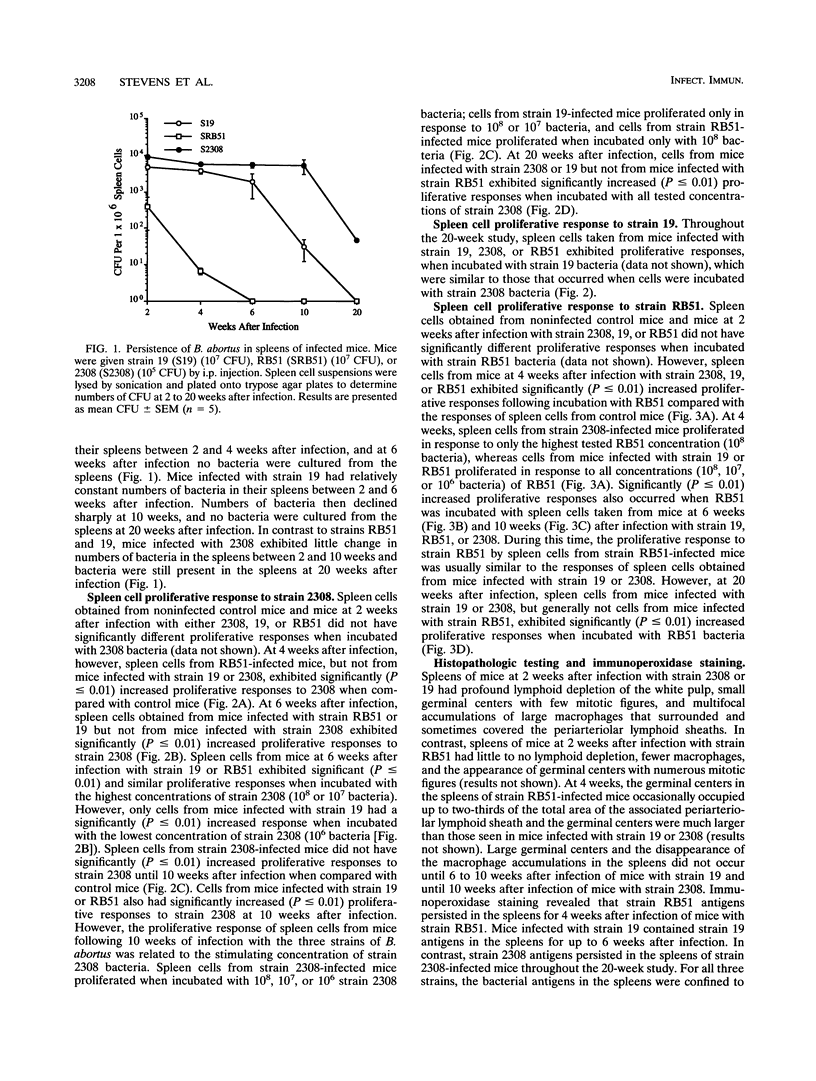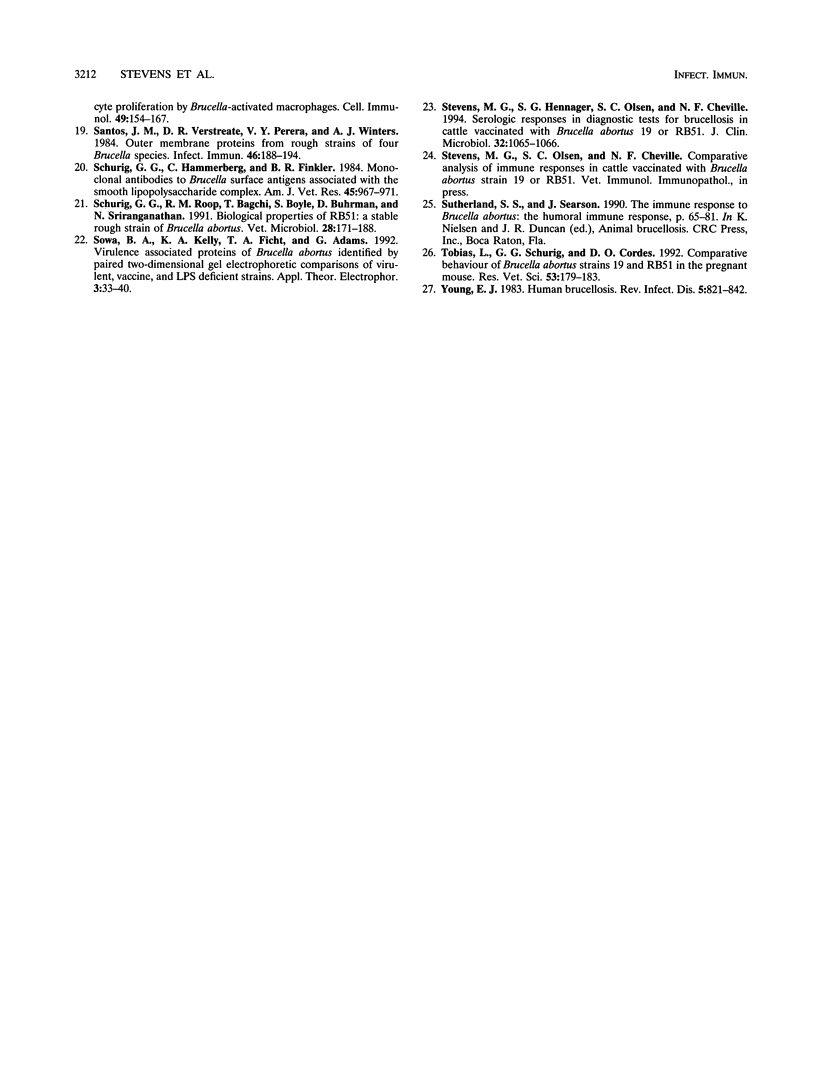Abstract
Immune and pathologic responses were measured for 20 weeks after infection of mice with Brucella abortus 19, RB51, or 2308. Live bacteria and bacterial antigens of 19 and RB51 persisted in spleens for 10 and 4 weeks after infection, respectively, whereas 2308 bacteria and bacterial antigens persisted for at least 20 weeks. Small germinal centers and profound lymphoid depletion occurred in spleens of mice during the first 4 weeks of infection with strain 19 or 2308; however, mice infected with strain RB51 had much larger germinal centers but no lymphoid depletion. At 4 weeks, only spleen cells from RB51-infected mice proliferated when incubated with 2308 bacteria. Large germinal centers in the spleen and spleen cell proliferative responses to 2308 did not appear in strain 19-infected mice until 6 weeks or in strain 2308-infected mice until 10 weeks. Similar proliferative responses to 2308 occurred in mice infected with strain 19 or RB51 at 6 weeks and in mice infected with strain 19, RB51, or 2308 at 10 weeks. However, at 20 weeks, spleen cell proliferative responses to 2308 occurred in mice infected with strain 19 or 2308 but not in mice infected with strain RB51. Mice infected with strain RB51 had lower and less persistent antibody titers to 2308 than did mice infected with strain 19 or 2308. Collectively, these results indicate that RB51-infected mice have less persistent immune responses to 2308 than do mice infected with 19 or 2308. The shorter duration of the responses probably resulted because RB51 is considerably less pathogenic and is cleared more rapidly from mice than are 19 and 2308.
Full text
PDF






Selected References
These references are in PubMed. This may not be the complete list of references from this article.
- Araya L. N., Elzer P. H., Rowe G. E., Enright F. M., Winter A. J. Temporal development of protective cell-mediated and humoral immunity in BALB/c mice infected with Brucella abortus. J Immunol. 1989 Nov 15;143(10):3330–3337. [PubMed] [Google Scholar]
- BRAUN W., POMALES-LEBRON A., STINEBRING W. R. Interactions between mononuclear phagocytes and Brucella abortus strains of different virulence. Proc Soc Exp Biol Med. 1958 Feb;97(2):393–397. doi: 10.3181/00379727-97-23752. [DOI] [PubMed] [Google Scholar]
- Cheers C., Pavlov H., Riglar C., Madraso E. Macrophage activation during experimental murine brucellosis. III. Do macrophages exert feedback control during brucellosis? Cell Immunol. 1980 Jan;49(1):168–177. doi: 10.1016/0008-8749(80)90066-0. [DOI] [PubMed] [Google Scholar]
- Cheville N. F., Jensen A. E., Halling S. M., Tatum F. M., Morfitt D. C., Hennager S. G., Frerichs W. M., Schurig G. Bacterial survival, lymph node changes, and immunologic responses of cattle vaccinated with standard and mutant strains of Brucella abortus. Am J Vet Res. 1992 Oct;53(10):1881–1888. [PubMed] [Google Scholar]
- Cheville N. F., Stevens M. G., Jensen A. E., Tatum F. M., Halling S. M. Immune responses and protection against infection and abortion in cattle experimentally vaccinated with mutant strains of Brucella abortus. Am J Vet Res. 1993 Oct;54(10):1591–1597. [PubMed] [Google Scholar]
- Enright F. M., Araya L. N., Elzer P. H., Rowe G. E., Winter A. J. Comparative histopathology in BALB/c mice infected with virulent and attenuated strains of Brucella abortus. Vet Immunol Immunopathol. 1990 Oct;26(2):171–182. doi: 10.1016/0165-2427(90)90065-z. [DOI] [PubMed] [Google Scholar]
- Harmon B. G., Adams L. G., Frey M. Survival of rough and smooth strains of Brucella abortus in bovine mammary gland macrophages. Am J Vet Res. 1988 Jul;49(7):1092–1097. [PubMed] [Google Scholar]
- Hasløv K., Fomsgaard A., Takayama K., Fomsgaard J. S., Ibsen P., Fauntleroy M. B., Stashak P. W., Taylor C. E., Baker P. J. Immunosuppressive effects induced by the polysaccharide moiety of some bacterial lipopolysaccharides. Immunobiology. 1992 Nov;186(5):378–393. doi: 10.1016/S0171-2985(11)80392-X. [DOI] [PubMed] [Google Scholar]
- Meador V. P., Tabatabai L. B., Hagemoser W. A., Deyoe B. L. Identification of Brucella abortus in formalin-fixed, paraffin-embedded tissues of cows, goats, and mice with an avidin-biotin-peroxidase complex immunoenzymatic staining technique. Am J Vet Res. 1986 Oct;47(10):2147–2150. [PubMed] [Google Scholar]
- Montaraz J. A., Winter A. J. Comparison of living and nonliving vaccines for Brucella abortus in BALB/c mice. Infect Immun. 1986 Aug;53(2):245–251. doi: 10.1128/iai.53.2.245-251.1986. [DOI] [PMC free article] [PubMed] [Google Scholar]
- Price R. E., Templeton J. W., Adams L. G. Survival of smooth, rough and transposon mutant strains of Brucella abortus in bovine mammary macrophages. Vet Immunol Immunopathol. 1990 Dec;26(4):353–365. doi: 10.1016/0165-2427(90)90119-d. [DOI] [PubMed] [Google Scholar]
- Pugh G. W., Jr, Tabatabai L. B., Phillips M., McDonald T. J. Establishment of dose-response relationships in BALB/c mice, using Brucella cell surface protein and lipopolysaccharide. Am J Vet Res. 1991 Feb;52(2):261–268. [PubMed] [Google Scholar]
- Pugh G. W., Jr, Zehr E. S., Meador V. P., Phillips M., McDonald T. J., Deyoe B. L. Immunologic, histopathologic, and bacteriologic responses of five strains of mice to Brucella abortus strain 2308. Am J Vet Res. 1989 Mar;50(3):323–328. [PubMed] [Google Scholar]
- Santos J. M., Verstreate D. R., Perera V. Y., Winter A. J. Outer membrane proteins from rough strains of four Brucella species. Infect Immun. 1984 Oct;46(1):188–194. doi: 10.1128/iai.46.1.188-194.1984. [DOI] [PMC free article] [PubMed] [Google Scholar]
- Schurig G. G., Hammerberg C., Finkler B. R. Monoclonal antibodies to Brucella surface antigens associated with the smooth lipopolysaccharide complex. Am J Vet Res. 1984 May;45(5):967–971. [PubMed] [Google Scholar]
- Schurig G. G., Roop R. M., 2nd, Bagchi T., Boyle S., Buhrman D., Sriranganathan N. Biological properties of RB51; a stable rough strain of Brucella abortus. Vet Microbiol. 1991 Jul;28(2):171–188. doi: 10.1016/0378-1135(91)90091-s. [DOI] [PubMed] [Google Scholar]
- Sowa B. A., Kelly K. A., Ficht T. A., Adams L. G. Virulence associated proteins of Brucella abortus identified by paired two-dimensional gel electrophoretic comparisons of virulent, vaccine and LPS deficient strains. Appl Theor Electrophor. 1992;3(1):33–40. [PubMed] [Google Scholar]
- Stevens M. G., Hennager S. G., Olsen S. C., Cheville N. F. Serologic responses in diagnostic tests for brucellosis in cattle vaccinated with Brucella abortus 19 or RB51. J Clin Microbiol. 1994 Apr;32(4):1065–1066. doi: 10.1128/jcm.32.4.1065-1066.1994. [DOI] [PMC free article] [PubMed] [Google Scholar]
- Tobias L., Schurig G. G., Cordes D. O. Comparative behaviour of Brucella abortus strains 19 and RB51 in the pregnant mouse. Res Vet Sci. 1992 Sep;53(2):179–183. doi: 10.1016/0034-5288(92)90107-d. [DOI] [PubMed] [Google Scholar]
- Young E. J. Human brucellosis. Rev Infect Dis. 1983 Sep-Oct;5(5):821–842. doi: 10.1093/clinids/5.5.821. [DOI] [PubMed] [Google Scholar]


